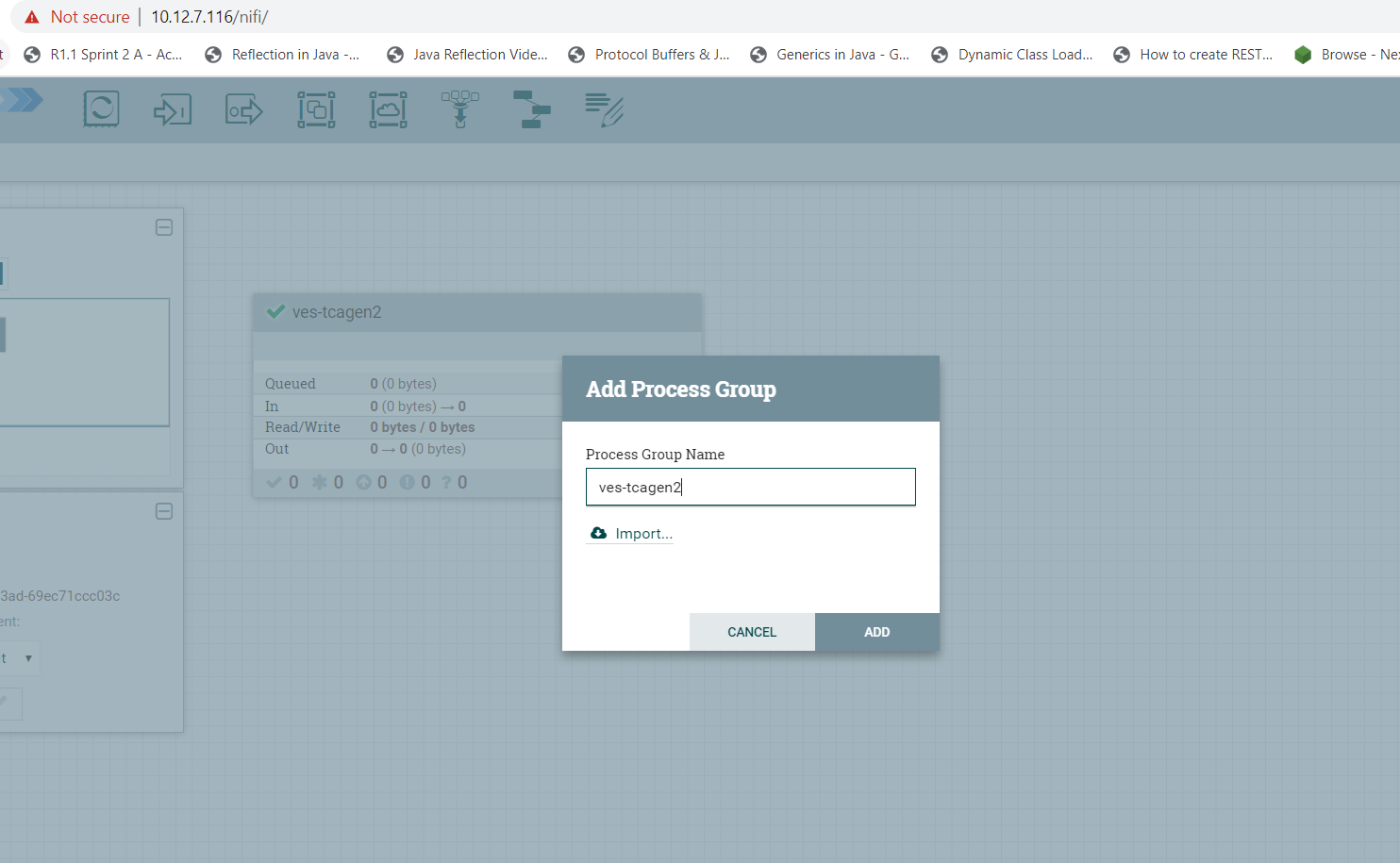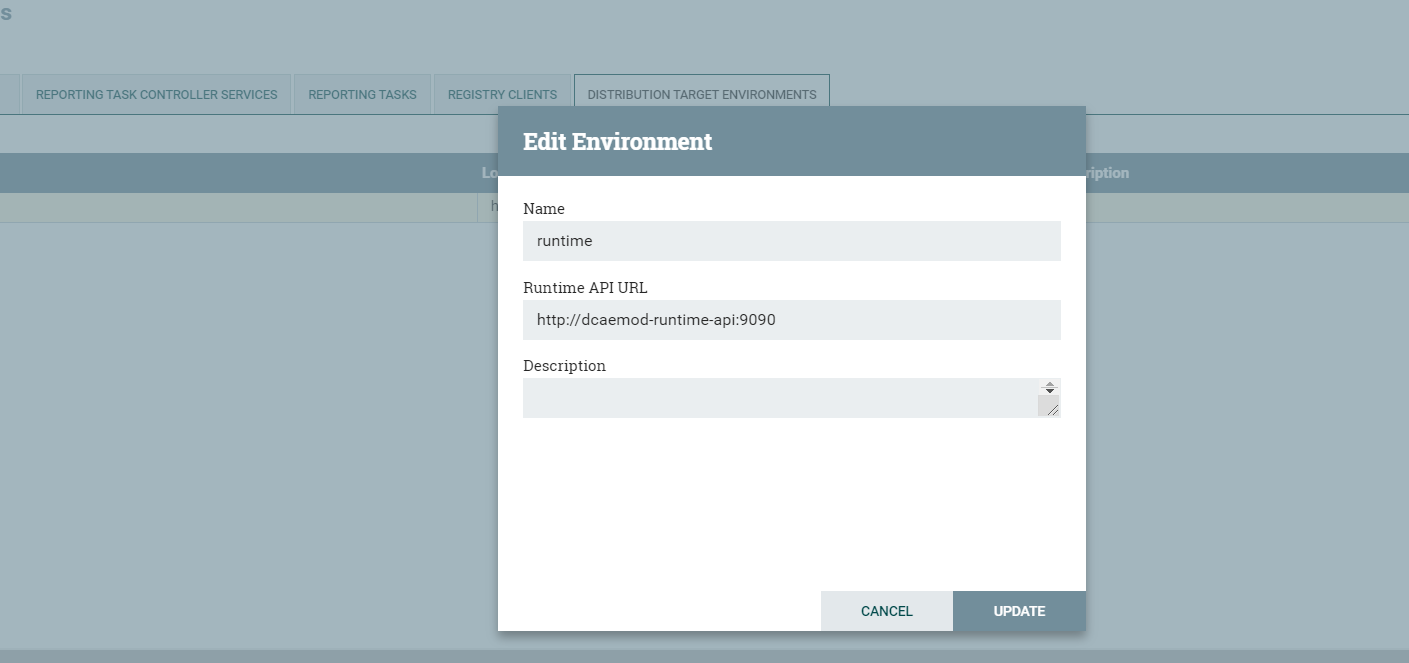| Table of Contents |
|---|
DCAE MOD User Guide
Types of Users and Usage Instructions:
...
...
Short Video Series available at : https://www.youtube.com/playlist?list=PLj-oRfbkqkfnN_2vnfhivCesJ118SA_zG
Demo day demonstration recording and slides available at : https://wiki.onap.org/display/DW/2020-04-16+DCAE+Demo
Types of Users and Usage Instructions:
Sr.No | User | Usage Instructions |
1. | Developers who are looking to onboard their mS | · Access the Nifi Web UI url provided to you · Follow steps 2.b to 2.d · You should be able to see your microservices in the Nifi Web UI by clicking and dragging ‘Processor’ on the canvas, and searching for the name of the microservice/component/processor. |
2. | Designers who are building the flows through UI and triggering distribution | · Access the Nifi Web UI url provided to you · Follow steps 3 to the end of the document |
3. | Infrastructure/ Admins who want to stand up DCAE Mod and validate it | · Follow start to the end |
1. Deployment of DCAE MOD components via Helm charts
The DCAE MOD components are deployed using the standard ONAP OOM deployment process. When deploying ONAP using the helm deploy command, DCAE MOD components are deployed when the dcaemod.enabled flag is set to true, either via a --set option on the command line or by an entry in an overrides file. In this respect, DCAE MOD is no different from any other ONAP subsystem.
The default DCAE MOD deployment relies on an nginx ingress controller being available in the Kubernetes cluster where DCAE MOD is being deployed. The Rancher RKE installation process sets up a suitable ingress controller. In order to enable the use of the ingress controller, it is necessary to override the OOM default global settings for ingress configuration. Specifically, the installation needs to set the following configuration in an override file:
...
| Code Block | ||||||
|---|---|---|---|---|---|---|
| ||||||
#Global ingress configuration ingress: |
...
...
enabled: |
...
true |
...
virtualhost: |
...
...
|
...
baseurl: |
...
"simpledemo.onap.org" |
When DCAE MOD is deployed with an ingress controller, several endpoints are exposed outside the cluster at the ingress controller's external IP address and port. (In the case of a Rancher RKE installation, there is an ingress controller on every worker node, listening at the the standard HTTP port (80).) These exposed endpoints are needed by users using machines outside the Kubernetes cluster.
...
Configuration Item | Endpoint URL |
Registry client | http://dcaemod-nifi-registry:18080 |
Distribution target | http://dcaemod-runtime-api:9090 |
Using DCAE MOD without an Ingress Controller
<to be supplied>
2. Configuring DCAE mod
As OOM/ingress template has been updated in Guilin release to enable virtual host, MOD API's and UI access via ingress should use dcaemod.api.simpledemo.onap.org
Add entry for dcaemod.simpledemo.onap.org in /etc/hosts with the correct IP (any of K8S node IP can be specified)
Using DCAE MOD without an Ingress Controller
Not currently supported.
2. Configuring DCAE mod
Our demo is hosted on 10.12.7.116. The IP Address for the purpose of this demo will hence be 10.12.7.116. In case of other deployments, we would have used the IP Address, or the DNS FQDN, if there is one, for one of the Kubernetes nodes.
Now let’s access the Nifi (DCAE designer) UI - http://10dcaemod.12simpledemo.7onap.116org/nifi/
a) Get the artifacts to test and onboard.
Let's fetch the artifacts/ spec files
A sample Component DCAE-VES-Collector : https://git.onap.org/dcaegen2/collectors/ves/tree/dpo/spec/vescollector-componentspec.json
A sample Data Format : https://git.onap.org/dcaegen2/collectors/ves/tree/dpo/data-formats/VES-5.28.4-dataformat.json
For the purpose of onboarding, a Sample Request body should be of the type -
{ "owner": "<some value>", "spec": <some json object> }where the json object inside the spec field can be a component spec json.
You would have to use a request body Request bodies of this type will be used in the onboarding requests you make using curl or the onboarding swagger interface.
The prepared Sample Request body for a component dcae-ves-collector looks like so
...
| Expand | |||||||
|---|---|---|---|---|---|---|---|
|
A The prepared Sample request body for a sample data format looks like so -
...
These requests would be of the type-
curl -X POST -u <user>:<password> http://<onboardingapi host>/onboarding/dataformats -H "Content-Type: application/json" -d @<filepath to request>
curl -X POST -u <user>:<password> http://<onboardingapi host>/onboarding/components -H "Content-Type: application/json" -d @<filepath to request> Inrequest>
In our case, curl
curl -X POST -u acumos:integration2019 http://10.12.7.116http://dcaemod.simpledemo.onap.org/onboarding/dataformats -H "Content-Type: application/json" -d @<filepath to request>
curl -X POST -u acumos:integration2019 httphttp://10dcaemod.12simpledemo.7onap.116org/onboarding/components -H "Content-Type: application/json" -d @<filepath to request>
You can download the Components and Data Formats for the demo from –
Components:
https://git.onap.org/dcaegen2/collectors/ves/tree/dpo/spec/vescollector-componentspec.json
https://git.onap.org/dcaegen2/analytics/tca-gen2/tree/dcae-analytics/dpo/tcagen2_spec.json
Corresponding Data Formats:
https://git.onap.org/dcaegen2/collectors/ves/tree/dpo/data-formats
https://git.onap.org/dcaegen2/analytics/tca-gen2/tree/dcae-analytics/dpo/
...
c) Verify the resources were created using
curl -X GET -u acumos:integration2019 http://10dcaemod.12simpledemo.7onap.116org/onboarding/dataformats
curl -X GET -u acumos:integration2019 http://10dcaemod.12simpledemo.7onap.116org/onboarding/components
d) Verify the genprocessor (which polls onboarding periodically to convert component specs to nifi processor), converted the component
Open http://10dcaemod.12simpledemo.7onap.116org/nifi-jars in / in a browser.
These jars should now be available for you to use in the nifi UI as processors.
3. Design & Distribution Flow
To start creating flows, we need to create a process group first. The name of the process group will be the name of the flow. Drag and Drop on the canvas, the ‘Processor Group’ icon from the DCAE Designer bar on the top.
a) Configure Nifi Registry url
...
Add a registry client. The Registry client url will be http://dcaemod-nifi-registry:18080
b) Add distribution target which will be the runtime api url
Set the distribution target in the controller settings
Distribution target URL will be http://dcaemod-runtime-api:9090
c) To start creating flows, we need to create a process group first. The name of the process group will be the name of the flow. Drag and Drop on the canvas, the ‘Processor Group’ icon from the DCAE Designer bar on the top.
Now enter the process group by double clicking it,
...
Note: Even if you move a component around on the canvas, and its position on the canvas changes, it is recognized as a change, and it will have to recommitted.
bd) Adding components and building the flow
...
The complete flow after joining our components looks like so
c) Add distribution target which will be the runtime api url
Once we have the desired flow checked in, we can go ahead and set the distribution target in the controller settings
Distribution target URL will be http://dcaemod-runtime-api:9090
de) Submit/ Distribute the flow:
...
The runtime is supposed to generate the blueprint out of the packaged design/flow and push it to the DCAE inventory and the DCAE Dasboard.
ef) Checking the components in the DCAE Dashboard
...
Finally, the generated Blueprint can be deployed.
You can use/import the attached input configurations files to deploy. Drag and Drop these sample JSON files to fill in the configuration values.
NOTE 1: Increase memory limit to 512Mi
NOTE 2: Verify image URL
| View file | ||||
|---|---|---|---|---|
|
| View file | ||||
|---|---|---|---|---|
|







